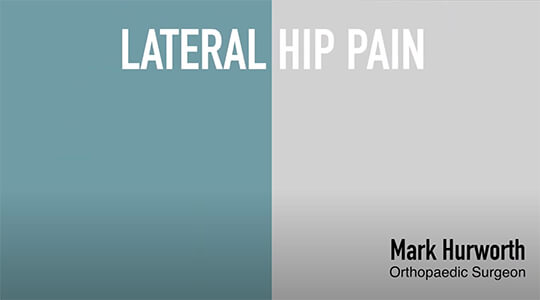Hip arthroscopy Perth
Hip arthroscopy
A hip arthroscopy is a technically complex procedure – the hip joint is deeper than other commonly arthroscoped joints and difficult to access as it is covered by a thick capsule. This procedure is used mainly for treating tears in the labrum (lining) of the hip, and associated bony spurs or impingement. At my practice, we first consider nonoperative options, and if you need this type of hip surgery, we make sure you are well informed to prepare and optimise your recovery.

My orthopaedic practice in a nutshell
Hip arthroscopy definition
What is hip arthroscopy and when is it used?
Hip arthroscopy is a surgical procedure used to treat damage to the tissues around your hip: the labrum, the articular cartilage or other soft tissues.
When you have a hip condition that causes pain and does not respond to nonsurgical treatment, I may suggest a hip arthroscopy. Typical conditions that may lead to this procedure are:
- Labral tearing
- Femoroacetabular impingement: spurs or bone overgrowth damages your soft tissues when you move your hip.
- Synovitis: inflammation of the tissues that surround your hip joint.
- Loose cartilage or bone: loose fragments that move around within the joint.
- Hip joint infection
As with knee arthroscopy, as you get older (especially over 50) hip arthroscopy will tend to make less difference to your symptoms as degeneration of the hip is almost inevitable, which may make it more realistic to wait until the condition requires a hip replacement.
Hip arthroscopy is not a simple or easy procedure. Your hip is a deep joint with a very tough capsule and gaining access involves putting you into a deep sleep, using muscle relaxants. When you are asleep, we place you on a traction table, to apply significant force to your leg.

Mr Mark Hurworth, Hip surgeon Perth
“I can then gain access to your hip joint with a telescope, often using an X-ray to confirm our position.”
Hip arthroscopy is relatively uncommon, compared to shoulder or knee arthroscopies. Yet, in my own orthopaedic practice, the operation occurs relatively frequently, as the high level of expertise required necessitates the procedure be performed often or not at all”
If there is a confirmed symptomatic labral tear, particularly if it is associated with impingement type pathology (pincer or cam impingement would be typical terms you hear) then arthroscopy may be recommended.
Labral tearing (the labrum is the lining of the hip, in the same way as the shoulder) is very common on MRI scans of asymptomatic hips (up to 50%). This means that having a labral tear does not necessarily mean that this is causing your symptoms.
As your specialist, I will look at your clinical history and examination findings. They often tell us more than what we see on the MRI image. Hip problems can lead to pain in the groin with hip flexion and rotation, which can sometimes radiate down the leg.
Hip arthroscopy for diagnosis & repair
Is hip arthroscopy used to diagnose or to treat?
In some situations, hip arthroscopy may be used just to diagnose, but over the last few decades this has become more unusual, as the quality of MRI imaging and their interpretation has improved. This has allowed us to pick up problems by looking at these high-quality images, without requiring arthroscopic surgery to support the diagnosis. We will often use a diagnostic injection into the hip joint to quantify how much of your pain is coming from the hip joint, if any.
Story continues below video gallery
Videos about hip conditions and surgeries
Preparing for hip arthroscopy
How can I prepare?
I realise from speaking to my patients in Perth that communication is key when you are scheduled to undergo surgery. We understand that a surgical procedure disrupts your daily life and activities, and that is why we want to make sure that you are well informed and well prepared.
Some important points:
- As mentioned, just because you have a labral tear does not mean you need surgery – they are present on about half the MRI scans of asymptomatic individuals.
We therefore want you to be clear on the diagnosis: If you are unclear about what exactly is wrong with your hip joint, what it means, or about one of the terms I have used, please ask. - We also want you to be sure that you have exhausted reasonable non-operative treatment such as changing particular activities (eg squatting), NSAIDs, time and sometimes injections.
- We will also talk about how to get the best outcomes by following the instructions and recommendations to optimize recovery after surgery.
- I may ask you to get as fit and light as possible before you have your surgery. If you are a little bit overweight, or you haven’t had much exercise or movement recently, we will talk about realistic ways to improve your situation. The fitter you are before surgery, the higher the chances of a smooth and effective recovery.
- Understand the risks: neurological injury is a recognized risk, because of the anatomy of the area, and the traction involved in getting into the joint. We take all possible precautions in protecting the skin and soft tissues, but there is still a 1:100 chance of traction related numbness in the perineal region which can be quite bothersome. Fracture and dislocation have been described, as has fluid from the operation leaking into the abdominal cavity. Damage to the joint when putting the telescope in can occur, as can penetration of the acetabular (socket) cartilage when putting in anchors for a repair.
Always bear in mind that your own efforts before and after this sort of surgery make a big difference. You will get the best of my surgical expertise, but it’s always important to remember that your own effort can shorten and transform your recovery process significantly.

Hip arthroscopy recovery
How do I optimise my recovery?
My patients know that I often talk about the static bike as an excellent tool for recovery. Within a few days after your surgery, I will typically recommend you spend some time on a static bike, followed by simple walking and an elliptical trainer.

Mr Mark Hurworth, Hip surgeon Perth
“Your recovery advice will be personalised, but in general, I do not recommend running on your hip for three months and sometimes longer depending on the nature of your hip surgery. Squatting is also typically something we avoid for 3 months.”
Other aspects of your recovery include:
- No driving (for a few days at least)
- Crutches (typically for two weeks)
- Perhaps an overnight stay (sometimes you may be able to go home on the day of surgery)
- 12 months of rehab if you are an elite sportsperson with a labral repair, in particular for contact sports
Getting those muscles to move is one of the best ways to get the best outcomes. It means that you can play an important role yourself, in achieving good results and successful recovery.
Hip arthroscopy surgeon Perth
Why choose Mr Mark Hurworth in Perth?
My patients know that I will often talk about avoiding surgery. As a surgeon, that might seem contradictory, yet I believe that discussing nonoperative options has its place. We have an unrushed consultation and try and put all the options on the table.
If surgery is recommended, we talk about the risks and make sure you have a clear understanding of the procedure, how best to prepare, and the time needed to recover.
Patients who have used my services will often share that they appreciate this transparency, because they felt heard and acknowledged, and did not feel pushed into a one-size-fits-all solution. Your hip problem is unique, and so is the solution we will find together to improve your situation.
It is often useful to have someone accompany you for a consultation for support and also to ask questions that you may have forgotten/remind you to ask questions. Write your questions down before you come.
Useful ways for thinking about questions can be found at www.choosingwisely.com.au.
If you have any questions about hip arthroscopy or any other type of hip surgery, please contact my rooms and we look forward to helping you.



